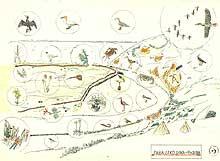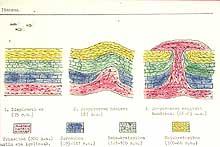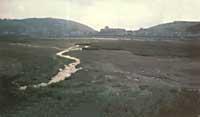Park of the banks of Zarautz
1988/02/01 Zarauzko Izadi Taldea Iturria: Elhuyar aldizkaria
From the beginning the term PARK will surprise some, but it has nothing to surprise. The word park brings us to the head something careful and protected, and there are urban parks, mountain parks, natural parks, etc. Among these types of parks are the parks of the Ribera, which originate around the banks of rivers or streams. But let's analyze the delimitation and ecological importance of this park.
The wild coast of the Basque Country is not the ideal place to create dunes by wind action. Therefore, we can say that the dune line on the eastern beach of Zarautz is an ecological relic.
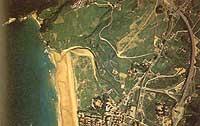
Coastal dunes are a unique ecosystem. They constitute a system in dynamic equilibrium with the sea, where living beings have had to obtain a high-level specialization to ensure their survival.
When we leave the sea inland we find the marsh of Zarautz. These marshes have suffered pressures of all kinds, leaving only some at the mouth of our rivers and streams. In the following pages we will see the ecological importance of these marshes.
Beyond the sea, the salt water marsh is transformed into freshwater marshes, with different types of plants and animals.
Since the zarauztarras have had the habit of calling the riverside to these areas, we have declared the park of Ribera.
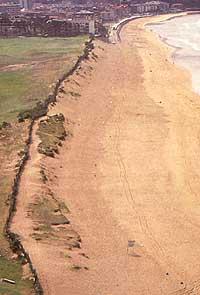
There are plenty of reeds, whose conservation is essential for native fauna.
Other ecosystems that appear within the park stand out: sea cliffs, sea slopes and host area. The set of ecosystems that complement the aforementioned are integrated within the park, being very important to maintain this set.
Before analyzing the different ecosystems of the park, we will make a summary of its geological history.
The geological history of Zarautz is very interesting, since the diapiro that is created has marked the geological structure of the area. Therefore, we will briefly analyze the changes that the diapiro has undergone within this story.
But what are diapiros? Some very plastic stones. In the situation of Zarautz, clay and plaster. They target areas of lower pressure under the influence of one or more efforts. When these efforts are lateral and superior, the inner materials will tend up deforming and breaking the rest of their layers. (See attached photo).
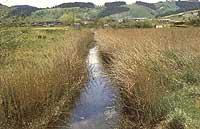
Lower tertiary (66-23 m.u. ), the diapiro followed its process. Then the plates Europa and Iberia collided. As a result, the Pyrenees arose and with it, under the sea of Zarautz, all the materials created or abandoned by the diapiro.
From now on violent erosion affected the entire area and the soft materials left by the diapiro were easily eroded, while the hard materials (Sta. Barbara and Talaimendi) remained there.
In view of the summary of the geological history, a landscape, fauna and plant mention is made.
After years and years, due to the fluctuations of the advance and recoil of the sea, the action of the wind, the erosion, etc., the bank of Zarautz was completed. On the front, a long hill of sand facing the sea, formed by action of the wind, forming to the south a beautiful riverside on the clay. In some way, the water that was located in the interior was going to be put to the sea and numerous streams were formed that eventually joined one greater. Crossing the sandy hill, the waters reached the sea. Precisely in that morphological formation that took place in the east of Zarautz, the park of Ribera is currently located.
Our ancestors began to live the most comfortable areas of the coast, continually altering the morphology of their surroundings: increasingly built began to settle on the beach and the dune. To the South, the wide plateau formed was divided by meadows and fields of cultivation. River channeling, roads, etc. were built later.
Today we have the last trace. It has been preserved as a relic. But let's keep telling history. XIII. In the 19th century Ferdinand III, when declaring the village of Zarautz, made a special mention of animals and plants. In a long list of animals he cited as many hares, foxes, wild cats, spinach, badgers, squirrels, partridges, quail, quail, quail, scabs, sea ducks, avefrío, bagausos, gulls, candles, etc.
Among the fish, anchovy, hake, conger, lobster, chicharros, sea bass, shellfish, squid, octopus, rodaballos, lengorados, etc.
In the plants it mentions oak, chestnut, walnut, ash, zumarrondos, laurels, fig, cherry and olive trees.
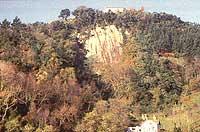
He also mentioned different types of flowers: roses, carnations, lilies, perpetual, lobelars, camamilas and lots of vegetables.
Many of them are currently in the park of Ribera, conferring the value of the mention. In addition XVIII. Some 20th century references confirm what this character said.
To finalize this historical summary, below are some references of travelers.
F. Wilhelm Mr. von Humbolt said: Zarautz is located in a marine strait. Its edge is sand and its state is dry and unbeautiful. The rear field does not present an abundance of spots in the territory so far. This man discovered a long dried plant dune without a doubt; he arrived in summer. At the back, carrizales were observed on the banks of the river, with a fairly scarce green color.
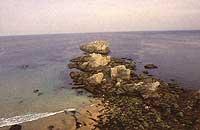
John Mañe and Flaquer (1866-1867) said: Zarautz is located on the shores of the Cantabrian Sea, at the foot of Mount Santa Barbara and on the western shore of a beautiful and wonderful plain with a central legion. The strip of beautiful hills that from the aforementioned mountain, to the end of Talaimendi, follows the culanca, gives the landscape a different circle shape that the sea inherits from the north.
The mention continues: One of Zarautz's most characteristic games is duck hunting. When the cold starts, from the North appear a lot of ducks and near the beach at nine or ten in the morning they turn around the village and return to the first place. At dusk the hunters head to the beach, where scattered (some here others) it is very nice to see the people of the village when lowering the ducks from the sea and waiting for the time to go to the mountains. There appears a lot of duck and a dark sky, so abundant...
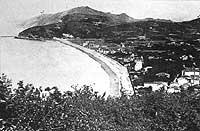
As you can see, the surroundings of Zarautz have been a very important place from a natural point of view, being even more important the park of Ribera that remains.
Different ecosystems of Ribera Park
Dunes. To the east of Zarautz, in the heart of the park, are the dunes. These dunes are mobile and fixed. The moving part is at the front (also in the river area) and is affected by the sea. At the back of these mobile dunes, within the golf course, the dune appears well settled thanks to the vegetation. In addition to the landscape importance of these dunes, the vegetation that appears in them is very important, some of them being one of the few in Euskal Herria.
This vegetation has very special adaptations: small and fleshy leaves, very violent root apparatus, good use of water, high osmotic concentrations, reduction of stomata...
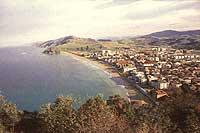
Note the presence in the mobile dune of species that do not appear in the consolidated dune. There are some that are endemic. There are references from the beginning of this century and are currently being developed in our park, and the role of all would be to preserve and love this natural heritage. We do not intend to talk about all the species present. We will only indicate that 46 species of dunes (psamophilic vegetation) have been classified.
The Izadi Group of Zarautz considers that 6 of these species are in danger of extinction in the Basque Country and 18 species are in danger of extinction in Gipuzkoa. On the other hand, there are many other forms of life in the dunes: snails, shackles, beetles, butterflies, insect sticks, dune grasshoppers, dune wasps, lizards, lizards and different birds.
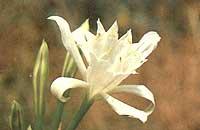
In almost the entire quaternary the sea water level was lower than now and the rivers dug into their deep mouth. When the ice melted the sea level increased and the bays were filled with sediments forming marshes with sea storms and rivers.
Marshes are one of the most productive ecosystems in the biosphere, mainly due to:
- The fertility of the marsh is guaranteed by the nutrients that are produced thanks to the contributions that the marine and river dunes, constantly present and sedimented in it.
- The vegetation that develops is of great value and some species seek their last residence in our park. We have classified 26 species of vegetation of this marsh, of great salt water content, one of them endangered in the Basque Country and 4 endangered in Gipuzkoa.
- The phenomenon of migration is very important. Waterfowl and limousines use these marshes to make fins. In our park we have visited 110 different species. 66 of them are under the law and are noteworthy: Large walls, ditches, gulls, herons, amilles, cranes, skyscrapers, morcillas, maremotos, chorlitos, timbres, brochas, kurlints, zancudos, abozetas, ducks, geese...
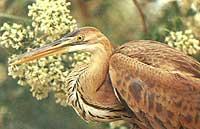
Ribera. To the south of the park appears the riverside. Despite the predominance of fresh water, pleamar also affects the area. In these conditions there are abundant living beings that appear in streams, reeds and alisedas. We can say that some of the species that appear on this bank are also one of the few in Euskal Herria.
To end the different ecosystems of Ribera Park, we have forgotten the sea cliffs, the host area, the slopes and the meadows, which are very important within the park. In it appear all kinds of living beings.
Special attention is given to the loader that appears on Moilarria. It began to work at the beginning of this century, but soon failed and this cultural historical heritage also reinforces the value of the park.
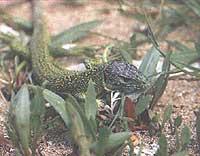
Once we analyze the evolution of Ribera Park and the different ecosystems, let's look at other problems. The Izadi Group of Zarautz, in the preparation of the preliminary project of this park, in addition to the geological, ornithological and botanical report, had to maintain the management of its territory.
The first problem was that in the very heart of the park was found the EMISARIO project, currently in operation. After a series of meetings with the members of the Corporation and responsible for the work of Zarautz, we leave our position clear, that is, the drain will give a big kick to the park (with some positive things) and in return we demand a series of concrete measures for the improvement of the park. You have to return what is taken away from you.
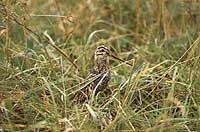
Another problem has been the filling, which is done without any control. After many complaints, it now seems that this problem can be solved. However, the Administration has not been able to verify the conduct.
On the other hand, there are other problems that are irreparable. For example, highway and stream pipeline. However, we have proposed a series of measures to make it look as natural as possible.
The existing streams and streams in the Asti area are very important for the park. It is proposed to leave a strip of reeds on the edge of everyone so that diverse fauna seeks refuge.
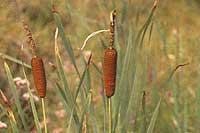
Finally, hunting is also worth mentioning. Hunting should be prohibited throughout the Ribera Park. When the cold squeezes in these areas, for many birds is the only refuge. It is also an ideal place to rest when it comes to a bird pass. It seems that this proposal will be fulfilled as soon as possible.

Gai honi buruzko eduki gehiago
Elhuyarrek garatutako teknologia




